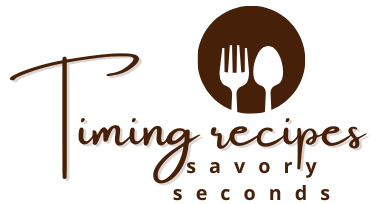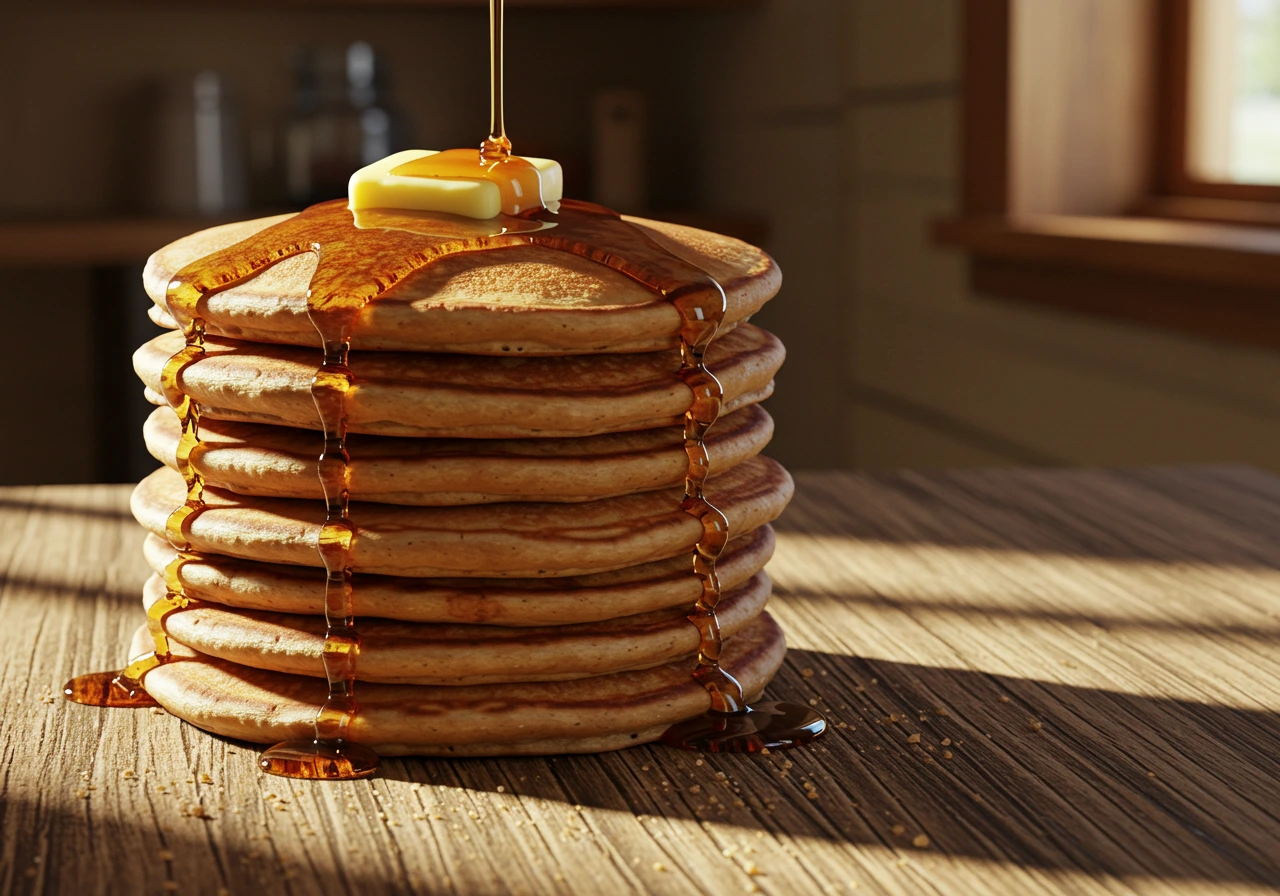Exploring the Origins of Pancakes
Pancakes are anything but new. In fact, these delightfully fluffy breakfast staples date back to prehistoric times. Archaeological evidence suggests that even our Stone Age ancestors were grinding grains and mixing them with water to form batter—primitive pancakes, if you will. Imagine that: humans were flipping their versions of flapjacks thousands of years ago!
Fast forward to Ancient Greece and Rome, and you’ll find pancakes—known as “tagenites” and “alia dulcia”—sweetened with honey and flavored with spices. These weren’t just morning meals; they were culinary centerpieces in feasts and festivals. From Renaissance banquets to colonial breakfasts in the New World, the pancake has evolved through centuries, retaining its charm and simplicity.
Oh, and let’s not forget Shrove Tuesday, better known as Pancake Day in many cultures—a tradition rooted in the need to use up rich ingredients before Lent. Pancakes have long been a way to celebrate abundance, indulgence, and community.
Pancakes Across the Globe: A Cultural Tour
Although we often associate the word “pancake” with the thick, buttery rounds from American diners, the world of pancakes is incredibly diverse.
- French Crêpes: Delicate, paper-thin, and utterly elegant. Crêpes can be sweet or savory, folded with fruits, Nutella, or ham and cheese. They scream sophistication.
- Russian Blini: These are smaller and often made with buckwheat flour, traditionally topped with sour cream and caviar. Blini reflect a celebratory Russian tradition.
- Ethiopian Injera: A sour, spongy flatbread made from teff flour. It’s not only a dish but also a utensil, as it’s used to scoop up spicy stews.
- Chinese Jianbing: A savory street-food breakfast pancake recipe packed with eggs, scallions, and crispy wonton crackers. It’s fast, fresh, and full of flavor.
- Welsh Crempog: Thick and hearty, these are closer to the American version but slightly chewier. They’re often served warm with butter and jam.
Pancakes are truly a global comfort food. While each culture puts its own spin on the ingredients and style, the love for something warm, cooked on a griddle, and loaded with love seems universal.
In truth, pancakes are the great equalizer. Rich or poor, young or old, everyone has a pancake story. Whether you’re waking up to maple syrup in Vermont or folding crêpes in Paris, you’re part of a delicious legacy.
The Rich History of Pancakes
Ah, pancakes. Just saying the word conjures up images of syrupy stacks, lazy weekend mornings, and that warm, buttery aroma floating through the air. But long before pancakes became a brunch staple or social media sensation, they were already a culinary classic in nearly every corner of the world.
Origins of Pancakes
Let’s roll the clock way back—prehistoric back. Archaeologists have found remnants of pancake-like foods in the stomachs of 5,000-year-old Otzi the Iceman. That’s right, even ancient hunter-gatherers were whipping up primitive pancake recipe batter using crushed grains and water cooked on hot stones. Simple? Yes. Delicious? We bet they thought so.
Moving ahead to ancient Greece and Rome, pancakes (or their ancestors) start showing some flair. The Greeks called them “tagenites,” often made with wheat flour, olive oil, honey, and curdled milk. Meanwhile, the Romans enjoyed a version called “alia dulcia,” translating to other sweets, prepared with eggs and milk—undeniably the first attempt at breakfast decadence.
But the pancake didn’t stay in the Mediterranean. As trade and migration spread across continents, so did this versatile flat cake. By the Middle Ages in Europe, pancakes were a common household treat, typically served during feasts. Ingredients varied by region and season, but the idea remained consistent: a batter-based food that could stretch far and satisfy many.
Back then, pancakes were associated with pre-Lenten traditions—Shrove Tuesday, or pancake recipe Day, gave families a chance to use up rich ingredients like eggs and butter before fasting. This ritual continues today in many parts of the world, keeping the spiritual and culinary essence alive.
Pancakes Around the World
Though the American-style pancake gets most of the pop-culture attention, it’s just one slice of the global griddle.
- French Crêpes: Whisper-thin and ultra-flexible, these beauties are enjoyed with everything from lemon sugar to smoked salmon. They embody elegance and are often found at street-side crêperies.
- American Pancakes: Thick, fluffy, and stacked high. These golden rounds are often drenched in maple syrup and butter, and they’re a Sunday brunch hero.
- Welsh Crempog: A denser, doughier pancake, usually made with buttermilk and cooked slowly on a bakestone. It’s a traditional teatime treat in Wales.
- Russian Blini: Made with buckwheat and yeast, blini are the stars of Russian cuisine—especially when topped with sour cream, smoked salmon, or even caviar.
- Japanese Soufflé Pancakes: These cloud-like wonders are all the rage thanks to their wobble and towering puff. They’re the supermodels of the pancake world.
- Ethiopian Injera: Though technically more of a flatbread, injera is made from fermented teff flour and serves as both a dish and a utensil. Its tangy, sponge-like texture makes it unique among its pancake cousins.
The global reach of pancakes proves one thing loud and clear: they’re beloved everywhere. From street food in Beijing to breakfast in Brooklyn, pancakes carry stories, flavors, and traditions that transcend borders. It’s not just a meal—it’s culture on a plate.
Understanding the Basics of pancake recipe Making
Creating the perfect pancake recipe doesn’t just happen by chance—it’s all about balance, baby. Ingredients and tools must come together like a jazz band: each player hits just the right note. Whether you’re flipping your first flapjack or finessing your five-hundredth, mastering the basics is crucial. So, let’s unpack the building blocks of pancake recipe bliss.
Essential Ingredients for the Perfect Pancake
Core Components
When it comes to pancakes, every ingredient earns its keep. Each one plays a distinct role in shaping texture, taste, and fluffiness. Let’s break it down.
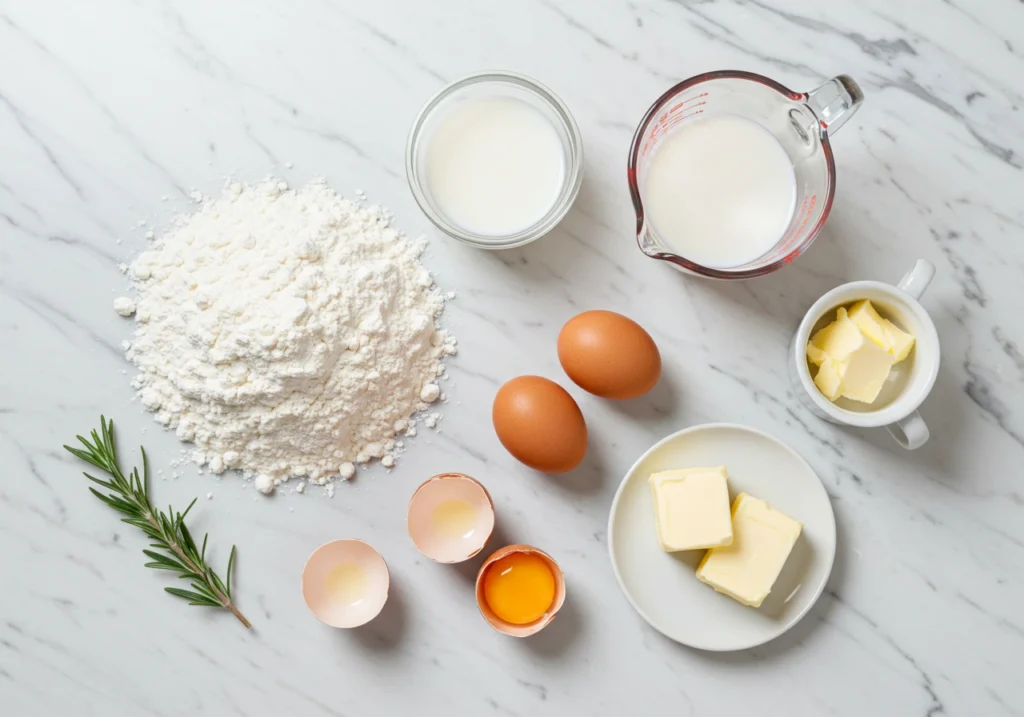
- Flour: This is your foundation. All-purpose flour is the most common and offers a lovely balance of structure and softness. For airier results, try cake flour. Craving a healthier version? Whole wheat flour adds fiber but can make pancakes denser, so pair it with a splash of extra liquid to keep things tender.
- Leavening Agents: Here’s where the science kicks in. Baking powder is the go-to for fluffy pancakes, while baking soda is typically used when acidic ingredients like buttermilk are in the mix. A teaspoon too much or too little can be the difference between cloud-like and hockey puck, so measure carefully.
- Liquids: Milk is standard, but buttermilk? That’s the real MVP. It lends a tangy depth and reacts beautifully with baking soda for an extra rise. For a dairy-free twist, almond or oat milk work well—just be mindful of their sweetness levels.
- Eggs: The unsung hero. Eggs add richness and help bind the batter. Want fluffier cakes? Separate the eggs and whip the whites before folding them in. Yep, it’s a trick chefs swear by.
- Fats: Butter brings buttery goodness (surprise!), while oils like canola or melted coconut offer subtle taste and a slightly crisper edge. Just don’t skip the fat altogether—it keeps pancakes tender and prevents sticking.
Optional Additions
Now, for the fun stuff—those little extras that elevate your pancakes from basic to brilliant.
- Sugars and Sweeteners: A tablespoon or two of granulated sugar boosts browning and sweetness. Prefer natural options? Try honey, maple syrup, or even mashed bananas for a wholesome upgrade.
- Flavor Enhancers: A dash of vanilla extract or a sprinkle of cinnamon goes a long way. Feeling adventurous? Cardamom, nutmeg, or orange zest can bring a delightful twist to your morning stack.
Tools and Equipment Needed
Let’s be real—you don’t need a Michelin-star kitchen to make good pancakes. But having the right gear helps a ton.
Cooking Surfaces
- Non-Stick Pans: These are beginner-friendly and fuss-free. They heat evenly, release pancakes easily, and require little to no added fat.
- Cast Iron Griddles: The pro choice. Once properly seasoned, they offer excellent heat retention and lend that golden, restaurant-style crust. Bonus: they last a lifetime.
- Electric Griddles: Ideal for feeding a crowd. You get even cooking across a wide surface and the ability to make multiple pancakes at once—hello, weekend brunch hero!
Utensils
- Mixing Bowls and Whisks: Go for a wide bowl and a balloon whisk. Together, they make blending easy and reduce lumps. Pro tip: mix wet and dry ingredients separately first to prevent overmixing.
- Measuring Cups and Spoons: Baking is a science. Precision matters, so use standardized tools, not that random mug in your cupboard.
- Spatulas: Flexible silicone spatulas are great for folding batter, while wide, thin flippers help you execute that perfect, drama-free flip.
Tried it myself: I used buttermilk, melted butter, and a cast iron pan for my weekend batch—and wow. Golden-brown, fluffy centers, with crispy edges that could rival any diner’s. It’s the kind of breakfast that makes you close your eyes on the first bite.
Step-by-Step Guide to Making Classic Pancakes
Let’s get down to the nitty-gritty of pancake recipe greatness. Making the best pancakes doesn’t require wizardry—but it does require a bit of science, a splash of patience, and a spoonful of love. In this part, we’ll walk you through every flip-worthy detail of making pancakes the right way. No guesswork, no lumpy batter—just golden results.
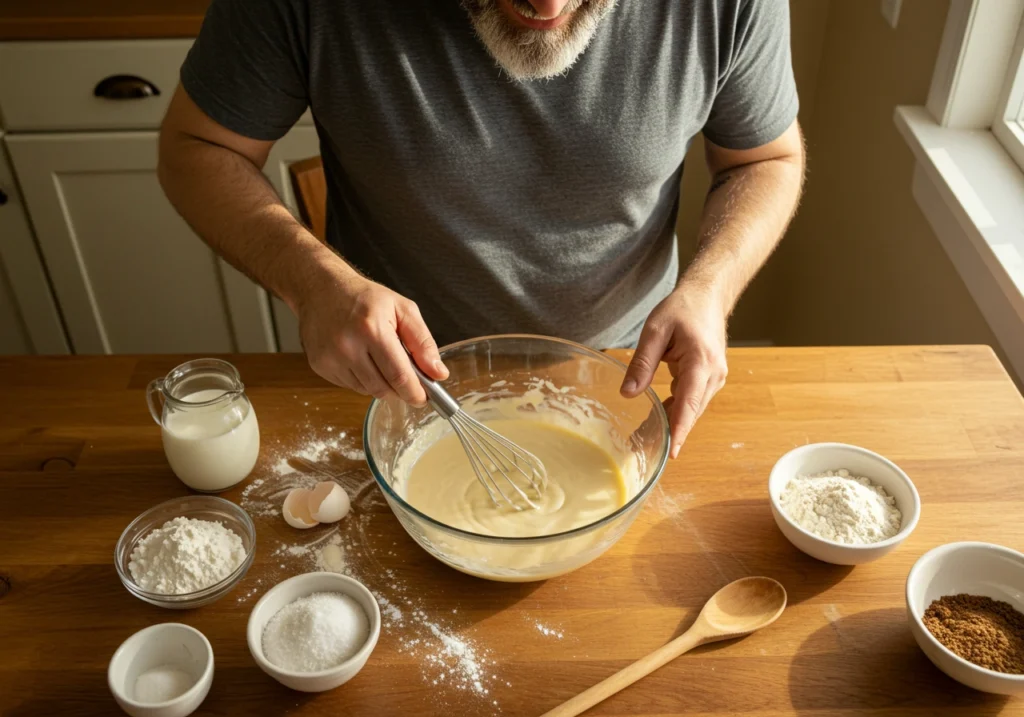
Preparing the Batter
Measuring Ingredients Accurately
It all starts with accuracy. Baking, unlike freestyle cooking, is an edible form of chemistry. That means precision matters—a lot.
When measuring dry ingredients like flour or baking powder, always spoon them into your measuring cup and level off with a flat edge. Don’t scoop directly from the bag—doing so packs the flour, and boom, your pancakes turn out heavy as bricks.
For liquid ingredients, use clear measuring cups set on a flat surface, then check at eye level. And always crack eggs into a small bowl first—trust me, you don’t want shell surprises in your batter.
Here’s a quickie pro tip: Want ultra-consistent fluff? Weigh your ingredients. A digital scale might sound geeky, but it’s the unsung hero in any baker’s kitchen.
Mixing Techniques
Now for the part where magic meets method.
Step one: Whisk all dry ingredients together—think of this as your flavor foundation. In a separate bowl, blend the wet ingredients until they’re smooth and unified.
Step two: Make a well in your dry mix and pour the wet mixture in. Gently stir until just combined. If the batter looks slightly lumpy—that’s perfect. Resist the urge to beat it into silky submission, or you’ll activate the gluten and end up with rubbery results.
Overmixing is the archenemy of fluffiness. Keep it casual, like you’re folding laundry, not kneading dough.
Resting the Batter
Here’s a secret most home cooks skip—and it makes a world of difference: let the batter rest.
Just 10–15 minutes allows the flour to fully hydrate and the gluten to relax, giving your pancakes a lighter, smoother texture. Plus, if you’ve used baking powder or soda, this resting time gives the leavening agents a head start to work their bubbly magic.
Pro tip: Cover the bowl with a towel or plate while it rests to keep it at room temperature and avoid drying out the top.
Cooking the Pancakes
Preheating the Cooking Surface
This isn’t just about flipping the switch and waiting for things to warm up. It’s about control. You want your pan hot—but not blazing.
Preheat your non-stick skillet or griddle over medium heat for 5 minutes. To test if it’s ready, sprinkle a few drops of water on the surface. If they dance and sizzle, it’s go time. If they sit there and frown, give it another minute.
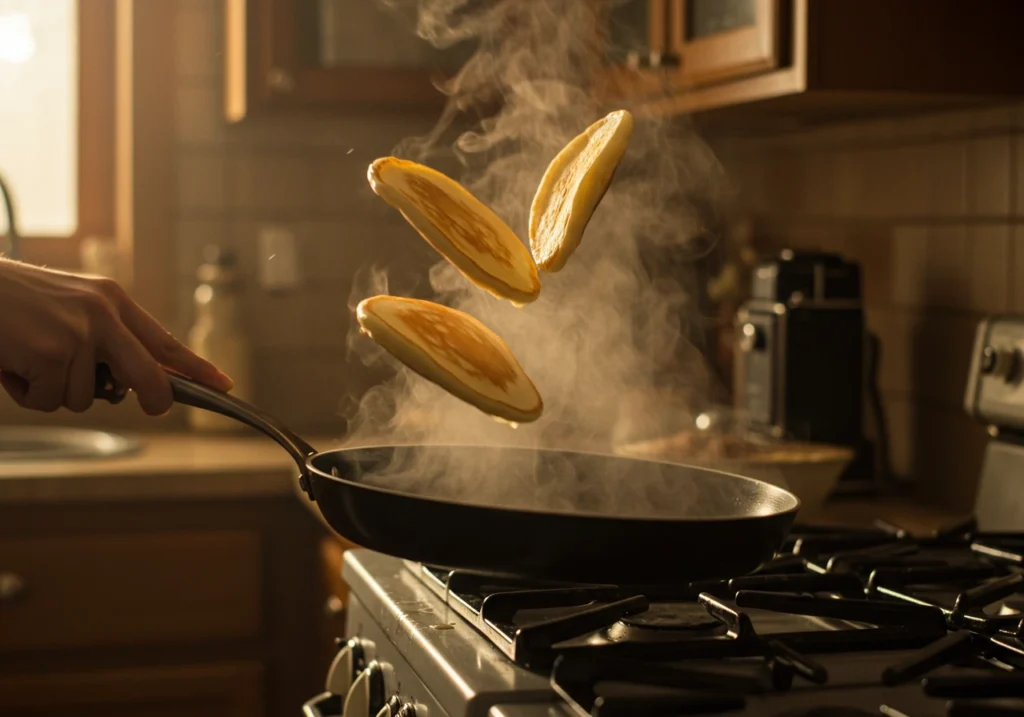
Too hot, and your pancakes will brown too fast, burning on the outside while staying raw inside. Too cool, and they won’t rise properly, soaking up oil like sponges.
Pouring and Spreading the Batter
Use a ¼-cup scoop for evenly sized pancakes. Pour the batter into the pan slowly and confidently—no panicking mid-pour.
Want perfect circles? Use a spoon to nudge the batter into shape. For thinner pancakes, gently spread the batter outward. For thick, fluffy stacks, let it sit naturally and puff up.
Consistency is key. If you want to avoid mess, use a squeeze bottle—it gives you total control.
Identifying When to Flip
Here’s where the artistry kicks in. Watch for bubbles forming on the surface and edges starting to set.
Once the bubbles start popping and the edges look a little dry, slide your spatula under and gently lift. The bottom should be a rich golden brown. Flip it with confidence—not too fast, not too slow.
From my own kitchen experiments, flipping too early results in splatter, while waiting too long can darken the pancake recipe more than desired.
Achieving the Perfect Golden-Brown Finish
After flipping, reduce the heat slightly and cook for about 1–2 minutes more. Your goal is that crisp edge with a fluffy middle, a pancake that stands proud but soft.
Always keep your eyes on the heat. As your pan retains warmth, you might need to dial it down. The first pancake is often a test run, so don’t be discouraged—it gets better from there.
Between batches, you can wipe the pan lightly with oiled paper towels to keep surfaces even and avoid dark spots from burnt batter.
Variations and Dietary Adaptations
So, you’ve mastered the classic pancake recipe—go you! But wait, why stop there? Pancakes are one of the most versatile foods on the planet. Whether you’re trying to eat healthier, skip the dairy, or simply jazz up your stack with creative flair, there’s a variation out there with your name on it. Let’s explore some wildly delicious twists that’ll keep your pancake game strong and inclusive.
Popular pancake recipe Variations
Buttermilk Pancakes
Ah, the buttermilk pancake—the Beyoncé of the breakfast world. What makes them so irresistible? That signature tang and pillowy softness.
Buttermilk’s acidity reacts with baking soda, creating a chemical leavening reaction that results in epic fluffiness. This means you’ll often need less baking powder and a pinch of baking soda to keep the chemistry balanced.
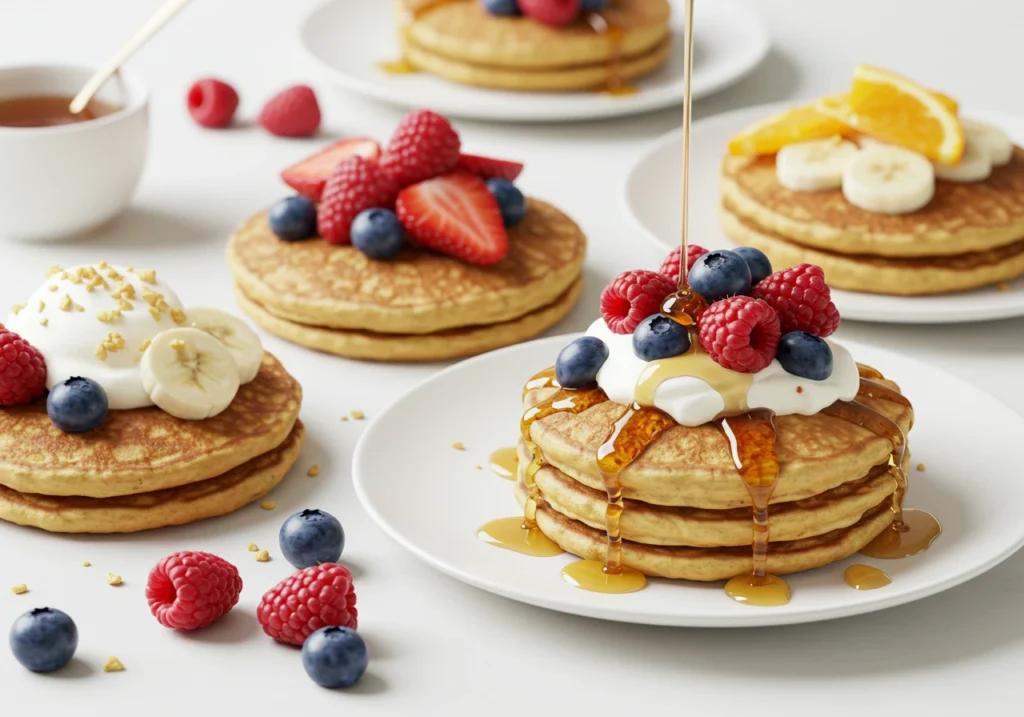
I recently tested a batch using this method, and wow—those pancakes were lofty and melt-in-your-mouth tender, like a cloud made of carbs.
Whole Wheat Pancakes
Looking to give your stack a healthy glow-up? Whole wheat flour brings extra fiber, protein, and nutrients to the mix. But there’s a catch—it can also lead to denser, drier pancakes if you’re not careful.
The trick is to add a splash more liquid, such as milk or yogurt, and let the batter rest longer to absorb moisture. You’ll get a hearty pancake recipe with a slightly nutty flavor—think rustic charm meets breakfast comfort.
Vegan Pancakes
No eggs? No problem. Vegan pancakes have come a long way, thanks to smart swaps that keep the texture fluffy and the flavor spot-on.
Use mashed bananas, applesauce, or flaxseed meal mixed with water as egg substitutes. For milk, go for almond, oat, or soy—just be mindful of their sweetness and adjust your sugar accordingly. Coconut oil or plant-based butter works wonders for richness.
Once, I whipped up a batch using flaxseed “eggs” and almond milk—they were shockingly good, with zero compromise on taste or texture.
Gluten-Free Pancakes
Whether you’re gluten-sensitive or just exploring alternatives, gluten-free pancakes can be seriously satisfying—with the right flour.
Popular picks include almond, oat, rice, or certified gluten-free flour blends. To avoid crumbling, make sure to add a binder like xanthan gum or a chia seed gel.
Texture can vary, but experimenting with ratios is part of the fun. Bonus tip? Let the batter sit for 10–15 minutes to allow hydration—it makes the pancakes more cohesive and less crumbly.
Incorporating Add-ins and Toppings
Now let’s talk toppings and add-ins, because sometimes pancakes need a little pizzazz.
Fruits and Nuts
Fruit in pancakes? Heck yes! Fresh blueberries or sliced bananas are classic, but don’t sleep on chopped apples, mango, or pomegranate seeds.
Fresh fruits offer juiciness and pop, while dried fruits like cranberries or raisins bring chewiness and concentrated flavor. Just be sure to chop dried fruits small so they distribute evenly.
And nuts? Toast ‘em first! Toasted walnuts or pecans add a savory crunch and enhance natural nuttiness. A quick pan-toast over medium heat does the trick.
Chocolate and Sweets
For those who treat breakfast like dessert (guilty), chocolate chips or cocoa powder make pancakes undeniably decadent. I once folded in dark chocolate chunks and topped them with marshmallows—it was s’mores meets breakfast bliss.
Drizzles are the cherry on top. Maple syrup is a must, but feel free to drizzle peanut butter, fruit compote, or even caramel sauce. A dollop of whipped cream or a dusting of powdered sugar? Go for it. YOLO.
